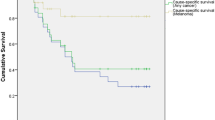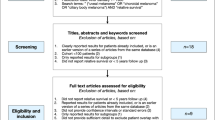Abstract
Background
The majority of Northern Irish uveal melanoma (UM) patients are diagnosed in Sheffield. This study aims to present incidence and survival outcomes for UM patients from Northern Ireland (NI).
Methods
Collaborative retrospective study between Sheffield and Northern Ireland Cancer Registry (NICR). For UM cases not on both databases, outcomes and survival rates (via Kaplan-Meier analysis) were compared. Anonymised NICR data were used to calculate whole-population incidence of UM for NI.
Results
In total, 161 patients from NI were diagnosed in Sheffield, 90 of which were not registered with NICR at the start of this study. Data-omissions were not consistent across patient groups, leading to significant differences between those patients registered and those not. Registered patients had an all-cause 5-year survival rate of only 68.9% compared to 92.5% of those not registered (p < 0.01) and were >17x more likely to have systemic metastases than those not registered (p < 0·001). Following rectification of data-omissions, the European age-standardised incidence rate of UM for NI was 8·6 per million.
Conclusions
This study illustrates the impact of incomplete population-wide data, serving as a real-world lesson in case-identification bias. Rare cancers are at higher risk of omission due to systemic failures as the small numbers involved are not detected by system-wide validation procedures. Following this study, data-transfer agreements between England and NI were actioned, preventing future data-omissions. We present survival and incidence data for UM in NI for the first time, showing the incidence is amongst the highest in Europe, with good survival rates.
This is a preview of subscription content, access via your institution
Access options
Subscribe to this journal
Receive 18 print issues and online access
$259.00 per year
only $14.39 per issue
Buy this article
- Purchase on Springer Link
- Instant access to full article PDF
Prices may be subject to local taxes which are calculated during checkout



Similar content being viewed by others
Data availability
Northern Ireland Cancer Registry data are available and can be accessed by direct application. The data for the Sheffield cohort can be accessed by written application to the authors.
References
Virgili G, Gatta G, Ciccolallo L, Capocaccia R, Biggeri A, Crocetti E, et al. Incidence of uveal melanoma in Europe. Ophthalmology. 2007;114:2309–15.
Baily C, O’Neill V, Dunne M, Cunningham M, Gullo G, Kennedy S, et al. Uveal melanoma in Ireland. Ocul Oncol Pathol. 2019;5:195–204. https://doi.org/10.1159/000492391.
Singh AD, Topham A. Survival rates with uveal melanoma in the United States: 1973–1997. Ophthalmology. 2003;110:962–5. https://doi.org/10.1016/S0161-6420(03)00077-0.
Virgili G, Gatta G, Ciccolallo L, Capocaccia R, Biggeri A, Crocetti E, et al. Survival in patients with uveal melanoma in Europe. Archives of ophthalmology, 2008. 126. pp. 1413-8. ISSN 0003-9950 https://doi.org/10.1001/archopht.126.10.1413
Beral V, Peto R. UK cancer survival statistics. BMJ. 2010;341:c4112 https://doi.org/10.1136/bmj.c4112
Kearney TM, Donnelly C, Kelly JM, O’Callaghan EP, Fox CR, Gavin AT Validation of the completeness and accuracy of the Northern Ireland Cancer Registry. Cancer Epidemiol. 2015;39:401-4. https://doi.org/10.1016/j.canep.2015.02.005.
AJCC Cancer Staging Manual 8th ed. 2017, Corr. 3rd printing 2018 Edition
Nathan P, Cohen V, Coupland S, Curtis K, Damato B, Evans J, et al. Uveal melanoma UK national guidelines. Eur J Cancer. 2015;51:2404–12. https://doi.org/10.1016/j.ejca.2015.07.013. Epub 2015 Aug 13. PMID: 26278648
International classification of diseases for oncology (ICD-O), 3rd ed., 1st revision3rd edition, 1st revision, https://apps.who.int/iris/handle/10665/96612
Stang A, Parkin DM, Ferlay J, Jöckel KH. International uveal melanoma incidence trends in view of a decreasing proportion of morphological verification. Int J Cancer. 2005;114:114–23. https://doi.org/10.1002/ijc.20690. PMID: 15523698
Vajdic CM, Kricker A, Giblin M, McKenzie J, Aitken J, Giles GG, et al. Incidence of ocular melanoma in Australia from 1990 to 1998. Int J Cancer. 2003;105:117–22. https://doi.org/10.1002/ijc.11057. PMID: 12672041
Iscovich J, Ackerman C, Andreev H, Pe’er J, Steinitz R. An epidemiological study of posterior uveal melanoma in Israel, 1961-1989. Int J Cancer. 1995;61:291–5. https://doi.org/10.1002/ijc.2910610302. 341 PMID: 7729936
Kaliki S, Shields CL. Uveal melanoma: relatively rare but deadly cancer. Eye. 2017;31:241–57. https://doi.org/10.1038/eye.2016.275
Gilbert E, O’Reilly S, Merrigan M, McGettigan D, Molloy AM, Brody LC, et al. The Irish DNA atlas: revealing fine-scale population structure and history within Ireland. Sci Rep. 2017;7:17199. https://doi.org/10.1038/s41598-017-17124-4. Erratum in: Sci Rep. 2018 May 3;8(1):7208.
Aronow ME, Topham AK, Singh AD. Uveal melanoma: 5-year update on incidence, treatment, and survival (SEER 1973-2013). Ocul Oncol Pathol. 2018;4:145–51. https://doi.org/10.1159/000480640
Garg G, Finger PT, Kivelä TT, Simpson ER, Gallie BL, Saakyan S, et al. Patients presenting with metastases: stage IV uveal melanoma, an international study. Br J Ophthalmol Published Online First: 15 January 2021. https://doi.org/10.1136/bjophthalmol-2020-317949
Steckler AM, Francis JH, Shoushtari AN, Abramson DH, Barker CA. Uveal melanoma metastatic at initial diagnosis: a case series. Melanoma Res. 2022;32:120–3. https://doi.org/10.1097/CMR.0000000000000807.
Rantala ES, Hernberg MM, Piperno-Neumann S, Grossniklaus HE, Kivelä TT Metastatic uveal melanoma: The final frontier. Prog Retin Eye Res. 2022:101041. https://doi.org/10.1016/j.preteyeres.2022.101041.
Robinson D, Sankila R, Hakulinen T, Møller H. Interpreting international comparisons of cancer survival: the effects of incomplete registration and the presence of death certificate only cases on survival estimates. Eur J Cancer. 2007;43:909–13. https://doi.org/10.1016/j.ejca.2007.01.007.
Acknowledgements
This research has been conducted using data from the Northern Ireland Cancer Registry (NICR) which is funded by the Public Health Agency, Northern Ireland. However, the interpretation and conclusions of the data are the sole responsibility of the author(s). The author(s) acknowledge the contribution of the NICR staff in the production of the NICR data. Like all Cancer Registries our work uses data provided by patients and collected by the health service as part of their care and support.
Author information
Authors and Affiliations
Contributions
HQ conceptualised the study, performed the literature search, study design, data collection, data analysis, data interpretation, produced the figures and wrote the original draft of the paper. JMJ contributed to data analysis, interpretation, and verification of the underlying data, produced the figures, and reviewed and edited the paper. IGR, AG and PR contributed to conceptualisation and methodology and reviewed and edited the paper. DF and GS contributed to data collection, data analysis, verification of the underlying data and edited the paper. SS and DC contributed to the review and editing of the paper.
Corresponding author
Ethics declarations
Competing interests
The authors declare no competing interests.
Ethics Approval and Consent to Participate
Ethical approval for the NICR databases (including the waiving of requirement for individual patient consent) and data analysis has been granted by the Office for Research Ethics Committees of Northern Ireland (ORECNI reference 15/NI/0203), recently renewed in October 2020 (REC REF 20-NI- 0132). This study complies with the declaration of Helsinki.
Additional information
Publisher’s note Springer Nature remains neutral with regard to jurisdictional claims in published maps and institutional affiliations.
Supplementary information
Rights and permissions
Springer Nature or its licensor (e.g. a society or other partner) holds exclusive rights to this article under a publishing agreement with the author(s) or other rightsholder(s); author self-archiving of the accepted manuscript version of this article is solely governed by the terms of such publishing agreement and applicable law.
About this article
Cite this article
Quhill, H., Jefferis, J.M., Rennie, I.G. et al. Incidence and survival of uveal melanoma in Northern Ireland: how incomplete data can skew results in rare cancers. Eye 37, 2454–2460 (2023). https://doi.org/10.1038/s41433-022-02352-4
Received:
Revised:
Accepted:
Published:
Issue Date:
DOI: https://doi.org/10.1038/s41433-022-02352-4



